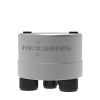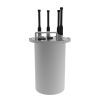Sequoia LISST-Tau Transmissometer
Features
- Measures optical transmission and beam attenuation
- RS-232 and analog real-time outputs
- Integrated temperature compensation & ambient light rejection
- Expedited repair and warranty service
- Lifetime technical support
- More
Overview
LISST-Tau is a high-precision transmissometer for underwater vehicles, profiling packages, CTDs, and other systems. With high-quality optics and a carefully selected LED source, it transmits a collimated beam through the water, and precisely measures the light transmitted through its 15 cm path. Light modulation with synchronous detection rejects ambient light, while oversampling and averaging yield better than 16-bit resolution. LISST-Tau’s digital controller applies calibration coefficients, corrects for temperature effects, and transmits data from both digital and analog outputs. Included software provides real-time display of data, and functions for checking and updating pure-water calibrations. An optional flow-through chamber simplifies calibrations and experiments. LISST-Tau advances the state of the art for in-situ transmissometers.
Remote Monitoring
The LISST-Tau transmissometer offers a plug-and-play interface to the NexSens X3 data loggers and telemetry systems. The X3 is available for pole-mount/buoy-based deployments with solar charging or connected to the X3-SUB submersible data logger with alkaline battery pack for subsurface deployments.
Parameters Measured
- Optical transmission
- Beam attenuation
Operating Ranges and Stability
- Operational temperature range: -3 °C to 40 °C
- Storage temperature range: -20 °C to 60 °C
- Beam attenuation range: ~0 m-1 to 30 m-1
- Linearity (concentration): >99 %
- Short-term stability (typical standard deviation over 1 minute)
- Transmission: 0.003 %FS (Green) / 0.005% (Red)
- Beam attenuation: 0.0002 m-1 (Green) / 0.0004 m-1 (Red)
- Long-term stability (6 hr test)
- Transmission: ~0.003 %FS/hr
- Beam attenuation: ~0.0002 m-1∙hr-1
Technology
- Optical path length: 15 cm
- Source wavelength: ~532 nm (Green) or ~650 nm (Red) LED
- Source spectral bandwidth: <10 nm FWHM
- Acceptance angle (half angle, in water): 1.0 °
- Optical transmission @ 16-bit resolution
Mechanical and Electrical
- Dimensions [Ø x L]: 5.1 cm x 40.6 cm (2.00″ x 16″)
- Weight [air / seawater]: 1.140 kg / 0.585 kg (2.5 lbs / 1.3 lbs)
- Depth rating: 2,000 m
- Sampling rate: 1 Hz
- External power input: 7 VDC to 25 VDC
- Current drain @ 12V: 42 mA average during sampling
- Connector: SubConn MCBH6M
- LISST-Tau transmissometer
- LISST-Tau 2-meter integrated communication and external power USB cable
- Windows software for real-time display of data, and functions for checking and updating pure-water calibrations
- Shipping case
In The News
Monitoring OAE Efforts in Halifax: Fighting Climate Change with Emerging mCDR Strategies
Marine carbon dioxide (CO 2 ) removal (mCDR) is an emerging strategy that aims to fight climate change by taking advantage of the carbon capture potential of our oceans. There are multiple types of mCDR approaches being evaluated globally, one of which is ocean alkalinity enhancement (OAE). According to NOAA , OAE aims to increase the pH of water by either adding alkaline material to ocean surface waters or by removing acid from seawater. Due to the change in acidity, the chemistry of seawater changes, making it capable of absorbing greater volumes of CO 2 .
Read MoreMonitoring Mariculture in the Gulf of Alaska
The mariculture industry in the Gulf of Alaska has been steadily growing in recent years, guided by ongoing research to help refine farm location and cultivation practices. A subset of aquaculture, mariculture focuses on rearing organisms in the open ocean. In Alaska, finfish farming is illegal, so most farms cultivate kelp, oysters, or a combination of the two. These small, locally operated farms started popping up in the Gulf of Alaska in the early 1990s, when shellfish farming first became legal. Kelp farming did not begin to catch on in the state until 2016. Many of the coastal areas that have grown interested in mariculture are historically commercial fishing communities.
Read MoreSupplying Seattle’s Drinking Water: Using Data Buoys to Monitor the Cedar River Municipal Watershed
Providing clean, safe, and reliable drinking water for the 1.6 million people in the greater Seattle area is a top priority for Seattle Public Utilities (SPU). With limited water supplies, SPU dedicates considerable resources to maintain its watersheds and mountain reservoirs. About 70 percent of Seattle Water comes from the Cedar River Municipal Watershed , and the other 30 percent comes from the South Fork Tolt River Watershed . [caption id="attachment_39574" align="alignnone" width="940"] Data buoy in Chester Morse Lake . (Credit: Kevin Johnson / Seattle Public Utilities) [/caption] Jamie Thompson, a fisheries biologist at SPU, monitors aquatic ecosystems centered on fish listed under the U.S. Endangered Species Act (ESA).
Read More

















